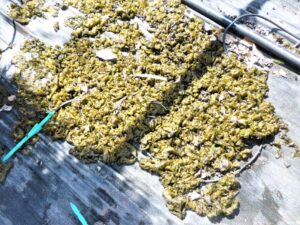Landscape, Ornamentals, Nursery, and Turf Edition
Seasonal updates on ornamental, nursery, and turf pests.
Subscriptions are available via EMAIL and RSS.
Companion Website Links:
 Rutgers Turf Blog - Articles on turfgrass diseases and cultural practices for the commercial turfgrass industry. Subscription available via RSS.
Rutgers Turf Blog - Articles on turfgrass diseases and cultural practices for the commercial turfgrass industry. Subscription available via RSS.
 Rutgers Weather Forecasting - Meteorological Information important to commercial agriculture.
Rutgers Weather Forecasting - Meteorological Information important to commercial agriculture.
NJACTS 2023: Resources for New Jersey Licensed Private Pesticide Applicators & Growers
New Webpage: WPS Resources Posted to Rutgers NJAES WPS Training Recordkeeping Webpage
Japanese Stiltgrass Control in Turf
Japanese stiltgrass (Microstegium vimineum) is a C4 summer annual grassy weed commonly invasive to forests. It can be problematic in lawns. Often it is problematic in shaded areas adjacent to an infested forest. But we have observed infestations in full sun turfgrass areas where you would normally expect crabgrass to be the predominant summer annual. […]
REGISTER BY FRIDAY: Pesticide Certification Testing NEXT Thursday 10am at NJACTS for New & Renewing New Jersey Applicators!
2x Nursery Sessions in Atlantic City Next Tuesday – 2023 New Jersey Agricultural Convention (ACTS) & Trade Show
I am happy to remind that Tim Waller (Cumberland) and Bill Errickson (Monmouth) will be holding two Nursery Sessions next Tuesday (Feb 7th) at the 2023 New Jersey Agricultural Convention & Trade Show (ACTS) hosted by the Vegetable Growers Association (VGA). The meeting is held at Harrah’s Resort Atlantic City.
This is a relatively new session for the nursery and green industries that Tim and Bill really pushed for, so PLEASE join us at this important agricultural event alongside many of the other commodities in NJ. Urge your friends and other growers to join as well so we can continue to bring in great speakers for this event.
Specifics:
- Click here to register and for more information
- February 7th (Tuesday)
- Harrah’s Atlantic City
- 2 Sessions with Pesticide CEU’s in 1A, PP2, 10
- Cost: $75 for 1-day pass (1 person), $120 for 3-day (2 people ($60 each)) + additional guest in your group $25 (cheaper option for multiple folks = grab a friend to come with).
Speaker highlight – View full schedule here get the full schedule here
Adam J. Kantrovich – Clemson (Extension Associate Professor of Agribusiness)
Dr. Kantrovich is an Associate Professor and Extension Economist with Clemson University and is located at the Sandhill Research and Education Center in Columbia, SC. Major responsibilities are programming activities in the areas of farm financials, ACA compliance for agribusiness, agribusiness succession and transition planning and agricultural and timber taxation management. Dr. Kantrovich conducts programs around the state and nationally to various agricultural groups and organizations. Click here for Dr. Kantrovich bio
- Speaking on: “What’s the Political, Policy, and Economic Landscape” (1-h afternoon session)
- Followed by a NRCS and FSA panel to speak about federal monies available to implement some of these ideas
Other speakers:
- Bill Errickson (RCE Monmouth Agent) – Native Trees for Low Input Landscapes
- Raul Cabrera (Nursery Extension Specialist) – Irrigation Management of Nursery Crops
- Steve Rettke (Nursery IPM) – Backyard Beneficials: Inviting Insects into the Landscape
- Lauren Errickson (Director of Rutgers Gardens) – Women in Horticulture Panel
- Aly Dyson and Stephanie Bouchelle (FSA), Fran Deficcio (NRCS) – Available NRCS and FSA Programs for Nurseries
- Tim Waller (RCE Cumberland Agent) – Management of Oomycete Root Diseases (with treatment regime handouts!)
Upcoming Events:
- Rutgers Speakers (and Educational Committee Planning) – TotalPro Expo (NJNLA)(Jan. 31st – Feb 1st)
- Rutgers Speakers (and Educational Committee Planning) – Landscape New Jersey (NJLCA) (March 1st)
- Tim Waller will be speaking about Phytophthora at Chesapeake Green 2023 (February 15 – 16th)
- Many more to come including Nursery IPM Training Sessions
Nostoc in Nurseries: Herbicides to Control the Slippery Slime Threat
Nostoc is a cyanobacterium and is one of the oldest organisms on earth (over 3.5 billion years). It is a primitive growth, like algae, moss, and liverwort. Many years ago, it was incorrectly identified as blue-green algae. Nostoc has no roots, no vascular tissues & is not a plant but it is photosynthetic. It can be found growing within gravel, stones, limestone chips, granite, saturated soils & on-ground cloth within container nurseries. It can tolerate long periods of desiccation but requires plentiful amounts of water for establishment. This cyanobacterium growth can become common & persistent at certain nursery/greenhouse sites where long-term overhead irrigation is done.

Nostoc growing in front of container bay opening. The opening allowed the overhead irrigation to saturate the soil/gravel at entrance. (Photo Credit: Steven K. Rettke, Rutgers Coop. Ext.)

Nostoc growing on ground cloth within a nursery container bay. Creates a serious slipping hazard for nursery personnel. (Photo Credit: Steven K. Rettke, Rutgers Coop. Ext.)
Nostoc is not toxic & does not directly compete with nursery/greenhouse crops or landscape plants, but it can harbor fungus gnats & snails. Nostoc first became a growing concern in nurseries approximately 30 years ago. Slipping hazards are the primary threat this organism poses to nursery & greenhouse personnel. It forms gelatinous masses composed of filaments linked together by protective jelly-like coverings. This creates a surface as slick as wet ice. Nostoc can occasionally be found growing within turf or landscape settings but is not common.
This blog will show with photographic images how Nostoc can be identified & will also review available control options.
